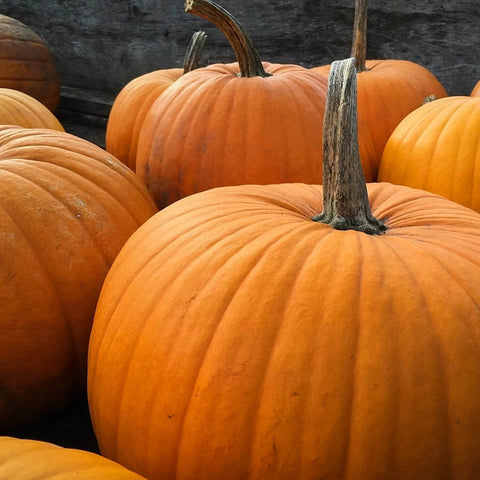

Hortinova
BIG MAX - Open Pollinated Pumpkin Seeds
Cucurbita maxima
- Late maturity.
- Very large exhibition sized fruit.
- Perfect for carving into Jack ‘o Lanterns.
- Thick, red-orange skin with bright yellow flesh.
- Open-pollinated seeds.
- Natural, Untreated, Non-GMO Seeds.
Start seeds indoor after the last spring frost using cell trays. Loosely pack some potting soil in a cell tray. Plant two to four pumpkin seeds 1 inch (2.5 cm.) deep in the soil. Water the pumpkin seeds just enough so that the soil is moist but not swamped. Place the cup on a heating pad. Once seeds have germinated, thin out all but the strongest seedling, then place the seedlings under a light source such us a bright window. Keeping the seedling on the heating pad will cause it to grow faster.
Pumpkins are sensitive to the cold. Do not sow seeds directly until well after danger of frost is past and the soil is between 65° and 95°F (18° to 35°C). If the soil is at 70°, seedlings should emerge in 5 to 10 days. For cooler climates, this is often in late May. Sow seeds 2cm (1″) deep in hills spaced 6 feet apart. Sow 3 seeds in each spot you want a plant to grow and thin to the strongest plant.
PLANT OUT: If sowing indoors, harden off seedlings before transplanting into warm, aged manure/compost-enriched soil. Try to get the plants into the ground no later than the summer solstice. Space plants at a minimum of 90-120cm (3-4 feet) apart in rows 120-180cm (4-6 feet) apart.
EXPOSURE: Pick a spot in full sun with space for sprawling vines to run: 50 to 10 square feet per plant. If space is limited, plant at the edge of the garden and direct vine growth across the lawn or paths.
WATER: Pumpkins need 1 inch of water per week. Water deeply, in the morning and on very hot afternoons, especially during fruit set. Avoid watering foliage and fruit unless it’s a sunny day. Dampness invites rot and disease.
FEED: Pumpkins are heavy feeders. It’s important to mix aged manure and/or compost into the soil. Side-dress with aged manure or compost mixed with water. When plants are about 1 foot tall, just before vines begin to run, fertilize regularly with a high-nitrogen formula. Just before the blooming period, switch to a high-phosphorus formula fertilizer.
PROTECT: Use row covers to protect plants early in the season and to prevent insect problems. However, remember to remove covers before flowering to allow pollination. Add mulch around your pumpkins to retain moisture, suppress weeds, and discourage pests. Weed gently; pumpkins have shallow roots that can be easily damaged. Also, take care not to damage the delicate vines; the quality of the fruit depends on them.
Harvest pumpkins when they are fully mature—and not before. They will keep best this way. Do not pick pumpkins off the vine because they have reached your desired size. (For smaller pumpkins, grow a small variety). Harvest on a dry day after the plants have died back and the skins are hard. The skin of a ripening pumpkin turns a deep, solid color (orange for most varieties) and the stem hardens. Thump the pumpkin with a finger; the rind will feel hard and sound hollow. Press a fingernail into the pumpkin’s skin; if it resists puncture, it is ripe. Carefully cut the fruit off the vine with a sharp knife or pruners; do not tear it. Be sure not to cut too close to the pumpkin. Leave 3 to 4 inches of stem to increase its keeping time. Handle pumpkins very gently or they may bruise. Never carry a pumpkin by its stem.
Let customers speak for us
from 23 reviewsWe grow several varieties of various colours of tomatoes, and the contrast of these tomatoes with other colours is fantastic. We've had a very long season with our plants, excellent disease resistance, great flavour.

This review applies to all of the seeds I purchased from Hortinova - beautiful tomatoes, good disease resistance and excellent production. Our field season extended to 10 weeks. We've had comments of excellent flavour from our customers as well, highly recommend any Hortinova seed.

This tomato is good taste tomato. Small red round tomato. Bigger then cherry tomatoes but smaller then regular one. I like it. Perfect for salads and fresh eating. Ordered seeds for next season.

2nd time ordering. Very satisfied with qualify and result. Thank you

BALCONY YELLOW F1 - Hybrid Cherry Tomato Seeds

Delivered very fast, packed very good, in professional condition and quality. Thanks

DUETT - Open Pollinated Radish Seeds

We will see what they are like this summer.

Type crimson de bonne grosseur avec une superbe uniformité et très hâtif. Un des premiers prêt en saison. Semences très petites et peu nombreuses. Goût très sucré et chaire croquante. Chair passant du rose au rouge en cours de saison. Les plants sont forts et très vigoureux avec des grosses feuilles.

Vigueur des plants impressionante avec des fruits résistants aux fissures et aux dommages. Très bonne conservartion et goût très sucré lorsque les nervures deviennent orange. Peu être récolté lorsque les nervures sont vertes également. Cavité des semences très compacte et petite laissant beaucoup de chair.

Melon qui fond en boûche avec un goût se rapprochant du melon miel et du cantaloup à la fois, très sucré. Faire attention aux irriguations lorsque le melon devient mature car il peut fendre au champs. Très odorant.

Avec son apparence côtellée, son très gros calibre et ça couleur rose, cette tomate se démarque des autres sur les tablettes. Variété plus résistante à la pourriture apicale que la plus part des autres tomates roses. Bon ensemble de résitance aux maladies également.

Tomate noire dont les faces qui ne sont pas exposé au soleil passent du vert au rouge lorsque mature donnant un aspect unique aux fruits. Charactéristiques similaires à la Barrio avec un goût superbe sans acide. Les clients l'on adoré.

Superbe adaptabilité et excellente résistance aux maladies. Fruits uniformes qui ne fendent pas, bonne conservation. Ajoutez à cela un goût unique avec une légère acidité et une pointe sucré.















